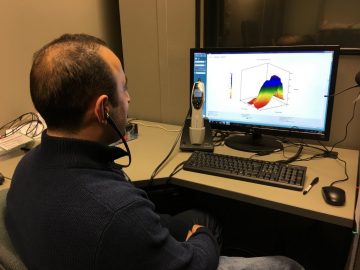Visit the Middle Ear Lab Website
Who We Are
The Middle Ear Lab research team:
Director: Navid Shahnaz, Ph.D. , Associate Professor
Ainsley Ma, MSc Student in Audiology, Shahab Ravanparast, MA, Charlene Chang, MSc Student in Audiology, Lareina Abbott, MSc candidate in Audiology, Esther Rhi, Chamutal Efrat, visiting MSc candidate in Audiology, Martine Schlagintweit, MSc candidate in Audiology, Samaneh Yekta, MSc in Audiology
New Research Themes in the Middle Ear Lab
Development of Test Protocol for Identifying Hidden Hearing Loss
There is evidence that listeners with a history of noise exposure but with normal audiograms have deficits in speech perception and temporal processing. Similarly, the aging process may affect speech perception in noise even when there are no significant increases in the audiometric threshold, and this may be related to a deterioration in temporal processing. Difficulty hearing in noise, tinnitus, and hyperacusis have all been reported in noise-exposed human ears with normal behavioural thresholds. This condition, which is also called hidden hearing loss (HHL), may also be key to the origin of other perceptual anomalies associated with noise damage and aging, including hyperacusis and tinnitus which may arise via an initiation of central gain adjustment secondary to loss of afferent input to the auditory central nervous system – CNS. The major goal of the proposed study is to understand the effect of age, noise exposure, tinnitus/hyperacusis and ethnicity on extended high-frequency audiometry, central auditory processing, and middle-ear transmission properties in the elderly group.
Translational Research in the Application of Wideband Acoustic Immittance (WAI) in the Clinical Practice
WAI is not a new procedure but rather an improvement of the measurement technique in the characterization of normal and diseased middle ear function across much wider frequency range than conventional tympanometry. To this end, we have established instrument, ethnic, age, and gender-specific norms for WAI parameters at ambient and tympanometric peak pressure. The outcome of these norms in creating a diagnostic profiling of otosclerotic ears, middle ear effusion, and other middle ear pathologies are being investigated. Recently we have looked at the impact of a cochlear implant in changing the middle ear mechano-acoustical properties in the adult population. We are also using WAI in the development of a novel newborn hearing screening protocol. This would enable us to develop a newborn hearing screening protocol that could also identify the type of hearing loss at the time of screening.

Effects of Middle Ear Pressure Compensation on Evoked Otoacoustic Emission and Power Absorbance in Adults
Rae Riddler, MSc in audiology investigated the effect of positive and negative middle ear pressure (MEP) on evoked otoacoustic emissions (EOAEs) both distortion-product OAEs (1.5 to 8 kHz), transient evoked OAEs (1 to 5 kHz), and wideband acoustic immittance measures of power absorbance (PA) in a normal-hearing young adult population. Results of her study suggest clinical benefit for a more accurate assessment of middle ear status and cochlear integrity for patients with abnormal MEP when EOAE are assessed at a compensated pressure level.
For more information, visit the Middle Ear Lab website